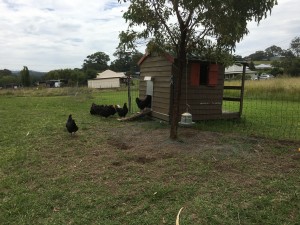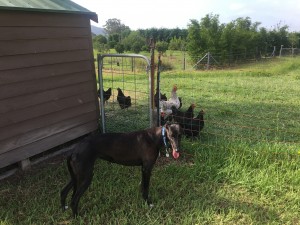Keeping backyard chickens has become very popular and with good reason. They make excellent pets and give us eggs in return. In this series we will explore how to care for your chickens, chicken selection and what health problems to look out for. Part 1 is all about how to house your chickens.
Everyone loves the concept of free range chickens but you will quickly realise chickens do a lot of damage to lawns and gardens. You will need to work out what style of coop will suit your yard. There are too many options to go into much detail here and there are lots of resources out there on coop design so I will stick to the basic principles. This information applies only to adult birds. If you are setting up for buying day old chicks or anything not fully feathered, you will need to keep them indoors with supplementary heat (a brooder) until they are fully feathered and able to survive outside.
Style:
There are many options of portable chicken tractors or more permanent coops. There are pros and cons to each depending on your situation. The key is to pick a style that will make caring for your chickens easy and keep them happy and healthy.
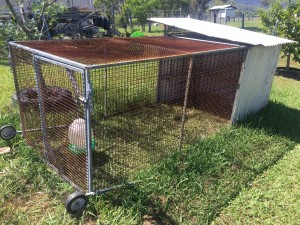
A home made mobile chicken tractor with an area for shelter and plenty of room to move around. The lid flips up for easy access to food and a nest box.
Chicken tractors don’t take up much space and have the benefit of being able to move the chickens to fresh lawn/garden reducing parasite build up that can occur when chooks are kept in the same location. They are also relatively inexpensive and allow flexibility in garden design. Chickens love to dig and will cause holes in lawn and compact the soil so you will need a relatively big area to move the chickens over if you want to keep your grass. It can work well in conjunction with rotation veggie garden beds where the chooks can clean up a spent crop, dig over the soil, remove pests and fertilise the ground ready for the next crop.
A permanent chicken house with or without a run is another option. The floor of the coop ideally needs to be concrete or timber elevated off the ground and covered so it is kept dry. A deep bed of wood shavings or saw dust makes a good substrate to provide soft flooring for the chickens feet. This can be cleaned out when required and makes an excellent garden fertiliser. If the floor is dirt it will become a mud pit in wet weather, it is impossible to properly clean and eventually there will be parasites building up in the soil and cause problems for the chooks.
A set up that has worked well for me is a converted cubby house I bought second hand. It has a raised ply wood floor it is fully enclosed from the elements with a couple of windows for ventilation. We have fitted a solar powered door that automatically closes at night keeping the chickens safe from predators until morning when they are let out. The chickens then have access during the day to a large run which is portable and we can move to fresh ground when required. If you do not have the luxury of space you could use the same system with a smaller permanent run or preferable two, so one can be rested while the other is in use and thereby maintain some grass cover.
If you are not precious about your lawn or garden, don’t have dogs that like to eat chickens and don’t mind chook poo all over the yard, then by all means let your chooks free range in the backyard. Be sure to protect any trees with chicken wire mesh or plastic square mesh. This can either be laid flat on the ground over the tree root zone or in a ring around the tree. Enthusiastic chickens will dig rather large holes under your favourite fruit tree if you are not careful. (I am speaking from experience!)
Size:
The size of coop you need will vary depending if you have access to a run or if they are in the coop full time. Current code of practice recommendations are for a minimum floor space of 3m2 for 3 large chooks or 6 bantams. Additional birds need an extra 0.4m2 for large breeds and 0.3m2 for bantams. These are minimum requirements and for household pets it is still fairly crowded so I would suggest more space per bird especially if they are not allowed access outside of this area.
Beware buying what look like chook mansions in photos off the internet. All too often I have seen people disappointed with a tiny coop that seemed so big in the picture and their chooks are cramped.
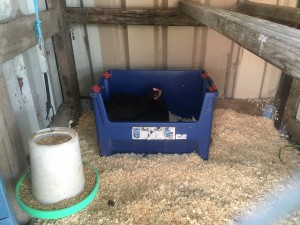 Nest boxes:
Nest boxes:
You will need one nest box at least 300mm2 per 4-5 chooks. To encourage chickens to lay in the nest box and not on the floor where they will get dirty, you can purchase plastic eggs to put in the nest box to show them where to lay. Fresh wood shavings or straw can be used in the nest boxes, I find the wood shavings keep the eggs cleaner as it is more absorbent. Clean dry wood shavings on the coop floor will help clean the chooks feet before getting into their nest box and help keep the eggs clean. Nest boxes can be wall mounted around 600mm off the floor or sit on the floor which heavier breeds may prefer.
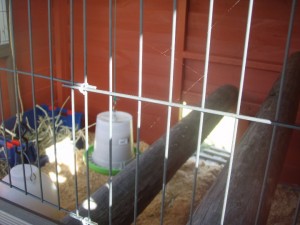 Perches:
Perches:
Chooks like to roost on a perch at night, wide perches slightly rounded are the most comfortable. Make sure there is enough perch space, there will often be competition for the best spot. They need at least 200mm for each hen. Ensure they can fly up to reach the perches, about 500mm height is suitable and do not position feed and water below perches where they will become easily contaminated with droppings.
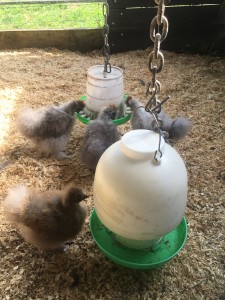
Silkie chicks eating and drinking. Ensure feeders and waterers are hung at appropriate heights for the size of the bird.
Food & Water:
There are variety of chicken food dispensers available, they need to be kept out of the rain and ideally so rodents can’t access them easily. A good quality commercial layer pellet supplemented with fresh fruit and veggie scraps is the best food but we will have more on nutrition in a later article.
A reliable source of water is vital, chooks can drink a lot of water on a hot day. Ensure it is big enough to hold enough water for all the chooks over a weekend if you are away. A second back up water dispenser is a good idea.
Predator proof:
Foxes can be a problem even in urban areas. Ensure your chickens are kept secure, especially at night from foxes. While some dogs are happy to leave chickens alone but there are many that will never be able to safely coexist with them and need a sturdy fence between them. Ensure the chicken run can’t be dug under or jumped over.
Wild birds:
Wild birds are attracted to chicken coops by food and can spread parasites and disease. If possible a cover to keep them out eg. netting, wire or a solid roof is a good idea.
Location:
There may be council regulations of type and location of backyard coops as well as restrictions on numbers of birds and roosters. Certainly keeping roosters in residential areas is not recommended if you want to stay on good terms with your neighbours.
When choosing a location for your coop, ensure there is adequate shade to keep the chooks cool on hot days.
To find Lake Macquarie’s Brochure on Keeping Animals in Residential Areas visit:
http://www.lakemac.com.au/council/animals
For more information on housing poultry:
http://www.dpi.nsw.gov.au/agriculture/livestock/poultry/production-small-scale/housing-layers
Coming soon: Chook Selection
Author: Dr Nicole Melhem is one of the veterinarians at Edgeworth Animal Medical Centre. She has a love for keeping backyard chooks and other poultry as a more ethical source of eggs and for the pleasure of seeing them scratching around the yard and enjoying life. They make fantastic pets for her kids who take great pleasure in feeding them and collecting the eggs each day.

